Top News
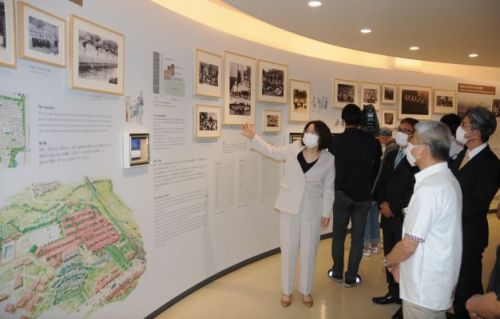
April 12, 2021 Ryukyu Shimpo
The Himeyuri Peace Museum in Itoman reopened on the morning of April 12 after having renewed their exhibition. The theme of the new exhibition is “A generation that moved away from war,” with the focused turned towards the employees who come from a generation that did not experience war.
The museum opened in 1989, and until its first renewal in 2004 it was centered around the students that were mobilized in the Battle of Okinawa. From 2005 it began an exhibit about those who grew up in an era of war, but the new exhibit after the latest renewal is the first time it was focused on employees who lived through an era without war. The exhibit uses illustrations and exhibits from close relatives who come from an era where experience with war was no longer common, and was devised using easy to understand expressions.
There was a tape-cutting ceremony for the re-opening of the museum on April 12, and museum director Chokei Futenma said in her remarks, “It was necessary for us to show that our grandparents’ generation was not a generation of war, we decided to renew the exhibit. I hope that many people come see our museum.” The museum is open from 9:00 a.m. to 5:25 p.m. and admission is free.
(English translation by T&CT and Sam Grieb)
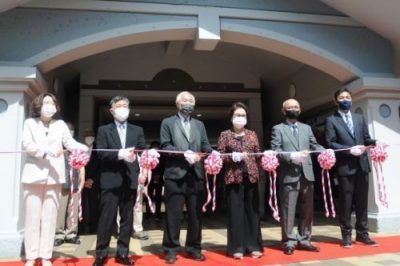
The tape cutting ceremony for the Peace Museum’s renewal
Go to Japanese
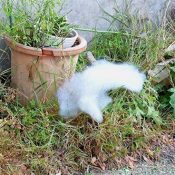
April 7, 2021 Ryukyu Shimpo
On April 7, study results were issued on the Japan Air Self-Defense Force (JASDF) Naha Base website concerning a recent incident in which a foam fire-extinguishing agent leaked off of said base. PFOS and PFOA, which are types of organic flourine compounds, were detected in contaminated water collected from on-base aqueducts into which the fire-extinguishing agent flowed. As such, words of apology were offered in the name of the base’s commander. The incident occurred on February 26, and although a base spokesperson initially said that “PFOS are not contained” in the agent, PFOS were detected in some foam gathered near the site of the incident by a Ryukyu Shimpo reporter.
The water was found to contain 3,010 nanograms of PFOS per liter and 3,380 nanograms per liter of PFOA, totalling 6,390 nanograms of these compounds per liter of water. The national provisional guideline value is 50 nanograms total of PFOS and PFOA per liter of water, and the detected value is 128 times this guideline value.
Naha Base’s commander explained that at the time concerns came to light he had announced PFOS were not contained in the foam fire-extinguishing agent that had leaked off-base, but the study results have established that PFOS are contained therein, and he apologizes and amends his former statement.
Another organic fluorine compound, PFHxS, has also been detected in the water at 3,040 nanograms per liter.
On April 7, the Naha City government also announced study results showed that a total of 360 nanograms of PFOS and PFOA per liter of water was detected.
Immediately after Naha Base exchanged the fire-extinguishing agent containing PFOS for a fire-extinguishing agent that does not use PFOS, analysis showed that PFOS components remain within pipes. When the agents were exchanged, the pipes were not cleaned out. A base spokesperson explained that “since the results of analysis by the Naha City government upstream and downstream of the base show a trend differing from the study results, we will conduct analysis again.”
The JASDF initially publicized that the fire-extinguishing agent does not contain PFOS, and poses little or no toxicity or harm. However, when the foam gathered near the site of the incident by the Ryukyu Shimpo reporter was analyzed by Associate Professor Kouji Harada of Kyoto University (specializing in environmental hygiene), results showed that PFOS was detected in the foam.
On the morning of April 7, this newspaper had placed an inquiry to Naha Base as to when the study results would be announced, and the response was that the study was ongoing.
(English translation by T&CT and Erin Jones)
Go to Japanese
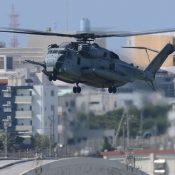
April 8, 2021 Ryukyu Shimpo
Chubu – On April 7, public elementary, junior high, and high schools held opening ceremonies and entrance ceremonies for the new school year. Despite having received requests to pause flights for the day from the boards of education in the area, U.S. military planes proceeded with flights at Kadena Air Base and Futenma Air Station. According to the Okinawa Board of Education, at high schools in Naha, entrance ceremonies were paused when what appeared to be U.S. planes flew overhead multiple times during the reading of students’ names.
That same day, the Okinawa Board of Education reported the situation to the Okinawa Defense Bureau and requested that flights be paused on April 8, when special education schools would hold their entrance ceremonies.
(English translation by T&CT and Ellen Huntley)
Go to Japanese
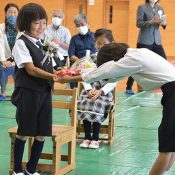
April 9, 2021 Ryukyu Shimpo
Higashi – Takae Elementary School in Higashi, Okinawa (Tatsuya Miyagi, principal), had their new student ceremony April 8. There was only one new first-grader, Hachimitsu Shoji, 6, the first new student in two years. The ceremony was attended by the school’s students, teachers, and about 20 people from the community.
Shoji looked nervous as she entered the ceremony, holding the hand of her teacher, and was welcomed by the audience with applause. Shoji said smiling, “I am looking forward to school lunch. I want to also do my best at the sports festival.”
Fifth-grader Maru Morioka, 10, welcomed the new student, saying, “I think there will be some things you are not used to, but let’s all do our best together.” Principal Miyagi brought a television screen into the auditorium with the first “lesson” telling the students, “Properly say your greetings, and take care of your lives.” Shoji was proactive in asking about anything she was unsure of, and was warmly attended to by those attending.
(English translation by T&CT and Sam Grieb)
Go to Japanese
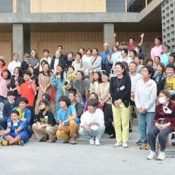
April 8, 2021 Ryukyu Shimpo
On April 4, Sangosya Scholé in Nanjo City, which operates free schools and night schools, hosted a gathering to welcome 17 new students for the 2021 academic year. Alumni, teachers, and other interested parties congratulated the new students, ranging in age from 10 to 88. President Hitoshi Hoshino said in his remarks, “Learning is hard to measure in points, but it shows in individual personalities. I hope to co-create learning [opportunities] and a dazzling school with you.”
The new students comprise five elementary school students, two junior high school students, six technical high school course students, and four evening junior high school students. The technical high school course just launched in April. The school, founded 20 years ago, recently relocated to a newly constructed building in Nanjo City where the new students will attend.
Second-year students Aoi Orio, 13, and Eita Taira, 13, organized the gathering. The fresh crop of students were seated atop a platform and appeared nervous at first, but their smiles gradually grew as the teachers and students, rich in individuality, welcomed them. The event concluded in a relaxed atmosphere and a group photo. Later that afternoon, the students performed a musical.
Rei Nakazato, 15, who enrolled this year as a freshman in the technical high school course, commented, “the teachers and students at this school don’t reject others—they accept and affirm us. I’m undecided about what I want to do, but I feel assured that I can think about it without anxiety.”
(English translation by T&CT and Monica Shingaki)
Go to Japanese
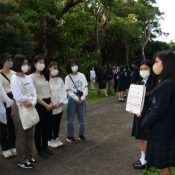
April 2, 2020 Ryukyu Shimpo
By Sanenori Kinjo
“Please try to imagine: girls just ten years old going to sleep only to be soon awoken and forced to work all day long under harsh conditions.”
On March 16, the Okinawa Shogaku Senior High School Regional Laboratory guided high school students visiting Okinawa for a school trip on a tour of the paths walked by the Shiraume students mobilized as nursing personnel during the Battle of Okinawa.
The Research Laboratory at the school has carried out fieldwork for 17 years, communicating and connecting with the former Shiraume students, listening to their stories from wartime, studying materials, and sharing what they learn as peace guides.
Fifteen members of the Regional Laboratory guided 23 students from the Hiroshima Jogakuin Senior High School in Hiroshima. The group visited the “surgery trench” and the Nunumachigama trench in Yaesedake in Yaese, as well as the Shiraume Memorial Tower in Itoman. The Laboratory students explained an overview of the Battle of Okinawa and the duties of the Shiraume students. The students from Hiroshima listened attentively with serious expressions on their faces.
At the Shiraume Memorial Tower, the group gave a one-minute silent prayer, and then entered the “lower cave” used as a hospital unit to experience what it was like in the cave.
During exchange of views between students from the two schools, the students from Hiroshima made comments such as, “I feel that there is a large gap between the opportunities for receiving peace education between high school students from Hiroshima, Okinawa, and Nagasaki and high school students from other areas. High school students all over Japan need equal opportunity to learn about peace.” Students from Okinawa Shogaku made comments such as, “There is much we do not know about the war experience in other prefectures as well. I hope to increase my knowledge through communication and exchange.”
On March 10, shortly before visiting Okinawa, the students at Hiroshima Jogakuin Senior High School heard from former Shiraume student Kiku Nakayama through an online session. Student Chisato Ichimura, age 17, said, “Since we went to the actual location after listening to Ms. Kiku’s talk, I was able to more deeply learn about the Battle of Okinawa.” Regarding the tour by the students from Okinawa Shogaku, she said, “They are of the same generation as us, but they have studied the Battle of Okinawa in detail and explained it to us in an accessible way. I hope that we, being born in Hiroshima, can also study more about the atomic bombing and convey our knowledge to many people.”
Karin Higa, age 17, of the Okinawa Shogaku Regional Laboratory said, “Explaining the Battle of Okinawa in my own words in practice served as an opportunity to think again about how to do so. I want to work to continue passing down the history of the Battle of Okinawa and the memories of the Shiraume students.”
(English translation by T&CT and Sandi Aritza)
Go to Japanese
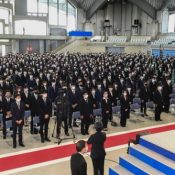
April 6, 2021 Ryukyu Shimpo
University of the Ryukyus had both their 2020 and 2021 new student ceremony April 6 at the Okinawa Convention Center in Ginowan.
First, a ceremony was had for the second-year students who entered the university in 2020, then again for the new students entering in 2021.
The first group of second-year students had their original new student ceremony cancelled due to the COVID-19 pandemic, and around 1,000 students attended the make-up ceremony this year. Hidemasa Izena, a student in the Global and Regional Studies department who missed the ceremony last year said, “Since entering the school most of the classes have been online, so it hasn’t really felt like I had entered college. Today, attending the ceremony and meeting my classmates in person for the first time, it finally felt like I had entered college for real. I want to make a lot of friends.”
The new student ceremony for the second group was attended by around 1,800 new students. Takumi Horiuchi, representing the new students, strongly pledged, “We promise to be stimulated by our studies, have our humanity enriched, and to adhere to the school regulations starting with the regulations at this school. University president Mutsumi Nishida encouraged, “I want to show my respect for your cooperation in overcoming all of these uncertainties. I want you to think independently, and act independently within the guidelines.”
As part of the coronavirus policies, only the students attended the ceremony.
(English translation by T&CT and Sam Grieb)
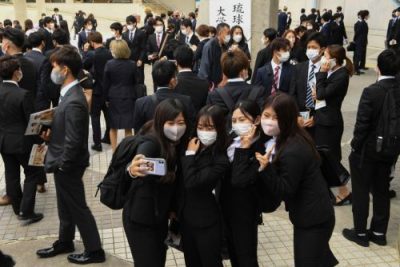
A group of friends taking a picture commemorating the ceremony after the event (photograph by Naoya Oshiro)
Go to Japanese

March 31, 2021 Ryukyu Shimpo
On March 31 the Bankoku Shinryo Conference on U.S. Military Base Issues (Bankoku Shinryo, meaning: bridge between nations) delivered its proposal for reducing the base burden on Okinawa, which includes the compiled discussions of the Conference from FY2020, to Governor Denny Tamaki. This Conference is an assembly of experts established by the Okinawa prefectural government (OPG). The proposal emphasizes the necessity of bringing public attention to the topics of alleviating U.S.-China antagonism and reducing the base burden on Okinawa. This proposal is the second sequential proposal since FY2019 and contains a strong request for spreading information, especially from the OPG, taking into account the new circumstances entering this fiscal year.
Bankoku Shinryo Conference Chairman Kyoji Yanagisawa (former Assistant Chief Cabinet Secretary) delivered this proposal to Governor Tamaki on March 31 at the Okinawa Harborview Hotel. Governor Tamaki replied that he wants to analyze the proposal and make certain that it is soon reflected in prefectural policy. Based on the proposal, he expressed interest in the idea of cooperating with the Hiroshima and Nagasaki prefectural governments to spread peace.
Chairman Yanagisawa said, “In Governor Denny Tamaki’s decision as a politician, I hope to see a stance for publicizing the move toward reduction of the base burden on Okinawa. The factors supporting this principle are incorporated in the proposal.”
As concerns the relocation of Futenma Air Station to Henoko, Nago City, the proposal expresses that Henoko is not “the sole solution” but rather “an extremely unlikely choice” based on the particulars posed by design changes from Japan’s government regarding improvement of soft ground. The proposal also emphasizes that the construction at Henoko should cease immediately, and requests that Japan’s government discuss, with the U.S. government and the OPG, policies for removing the dangers of Futenma Air Station and ceasing the use thereof without involving construction at Henoko.
The proposal contains recognition of the fact that the US military, which is rolling out a new strategic plan as antagonism between the US and China intensifies in the background, considers Okinawa as an important military position. On top of this, the proposal highlights the importance of the OPG and Japanese government making certain that public opinion in favor of reducing the burden on local populations is reflected in their policies.
Although the necessity of drastically revising the U.S.-Japan Status of Forces Agreement is thrown into relief as training exercises by the U.S. military increasingly intensify nationwide, the proposal raises the topic of concluding agreements, concerning U.S. military use of military bases, with local defense bureaus as a means for granting capability to the localities that host military bases. The proposal includes a specific example of such and provides a sample agreement.
(English translation by T&CT and Erin Jones)
Go to Japanese
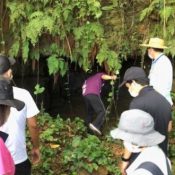
April 2, 2021 Ryukyu Shimpo
By Wakana Arakaki
The Chatan Board of Education is set to offer “peace education training” to all of its elementary and junior high school faculty this academic year. While many municipalities in Okinawa offer peace training to first-year and mid-career educators, Chatan will be the second municipality, following Nakagusuku Village, to train teachers at all levels. Faculty members of all six elementary and junior high schools in Chatan will receive the peace education training during summer vacation, two schools per year, over the next three years.
The training will kick off with a visit to Abuchira-gama in Nanjo City but will vary by school beyond that. Kuwae Junior High School, which will train its teachers this year, plans to tour the local WWII sites. In the past, peace training for first-year teachers in Chatan included visits to the Kumaya-gama, a secret bunker for the marure suicide boats.
Chatan School District Superintendent Nobuyuki Tsukayama said, “Fieldwork allows us to experience the realities of the Battle of Okinawa which may not be gained from reading alone. I hope [the teachers] will continuously explore and think about their own teaching methods.”
The Okinawa City Heiwa (Peace) Guide network, a group of retired teachers, and others expressed concern about the educators’ lack of knowledge on the Battle of Okinawa and requested the municipality to take the initiative on educating its teachers. Originally, the town budgeted and planned the peace training for the 2020 academic year. However, it was canceled due to the novel coronavirus pandemic and delayed until this year.
Noboru Morine, 79, representative caretaker of the Okinawa Peace Guide Network, emphasized, “Some textbooks have an incorrect understanding of history. That is why I want all educators to value historical facts, site visits, and testimonies. I hope they nurture their interest in the topic and continue their learning.”
(English translation by T&CT and Monica Shingaki)
Go to Japanese
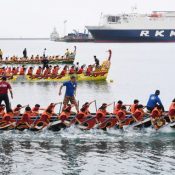
March 31, 2021 Ryukyu Shimpo
Naha City announced March 31 that in order to prevent the spread of COVID-19, they would be cancelling the 47th annual Naha Hari races scheduled to take place from May 3-5 at the Naha Port Piers. This is the second straight year the event has been cancelled. The race’s board of governors said, “Since we cannot forecast the state of the coronavirus pandemic [at the time of the race], it is exceedingly difficult to create an environment where participants and spectators can enjoy the festivities safely,” deciding to cancel the event after a written resolution by the race’s executive committee.
The Naha Hari is an annual tradition that brings color to Naha during Golden Week, and in addition to the dragon boat races, the area also features fireworks and live music among other activities. Instead of the races, there will be a special exhibit at the Naha Hari Museum in Tomari, Naha from May 3-5. Visitors will be able to board the dragon boats and take pictures.
(English translation by T&CT and Sam Grieb)
Go to Japanese
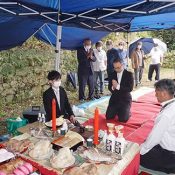
March 29, 2021 Ryukyu Shimpo
On March 28, the Ushimi, a ritual visit, was performed at Tamaudun Royal Mausoleum in Shuri Kinjo and at Fungaku Sanryo in Shuri Yamagawa, both in Naha. Generations of monarchs of the Second Sho Dynasty of the Ryukyu Kingdom are entombed at Tamaudun, and Fungaku Sanryo is the Chin-udun cemetery.
Due to measures intended to prevent the spread of Covid 19, the ceremony this year was smaller than in normal years. Advisor Yu Sho and Choshu Kinjo from the Chin-udun Munchu Kai, an association of Chin-udun descendants, participated in the Ushimi at Tamaudun, honoring generations of kings. Sho also brought his hands together facing the direction of Shuri Castle, and said, “We pray for the castle to be restored as soon as possible.” At the same time, Takeru Sho, of the 24th generation of direct descendants of the Second Sho Dynasty, performed the yohai, or a prayer from afar, in Tokyo.
Afterwards, at the Ushimi held at Fungaku Sanryo, offerings were made of chicken, pork, sugarcane, and manju. Participating descendants of the Chin-udun performed the shi hairei, in which an individual kneels, brings their hands together in prayer, bows with their forehead touching the ground, and stands, repeating the series of motions four times.
After the abolition of the han system and establishment of the prefectures of Japan, members of the Chin-udun Munchu Kai, who descend from King Sho Kyu, father of Sho Ho, eighth king of the dynasty, have performed the Ushimi at Tamaudun every year, except during the Battle of Okinawa.
(English translation by T&CT and Ellen Huntley)
Go to Japanese













 Webcam(Kokusai Street)
Webcam(Kokusai Street)


